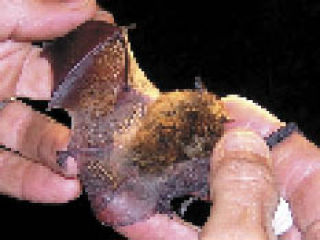Natural History
Night fliers
Looking for a safer insecticide? Build a bat house!
Washington State is home to 15 species of bats. Nine have been confirmed thus far in San Juan County, including three threatened species. All of our island bats are insectivores, and a single bat can consume thousands of mosquitoes and other flying insects every night. Bats hunt mainly over wetlands and open fields, like swallows, our other key natural flying insect control. Both rely on extraordinary speed and maneuverability to chase and catch insects. While swallows track insect prey visually, bats use a kind of sonar – like a fish finder – making ultrasonic cries inaudible to humans that bounce off insects, trees and other objects giving the bat a three-dimensional “view” of its surroundings as well as the speed and trajectory of flying targets as tiny as a gnat.
Insects are not helpless, however. A study just published in the journal Nature reports that some of our tiger moths are not only poisonous but advertise their toxicity to bats by emitting ultrasonic clicks that only bats can hear!
Bats are most vulnerable in spring when they mate and nurse their offspring. Female bats aggregate in large “maternity colonies” in caves, old barns, and other protected areas. An infrared camera is the best and least intrusive way to document roosting bats. It produces a black-and-white image of the bats’ body heat, and does not disturb the bats. Our bats also need safe places to hibernate, although some may winter on the mainland or farther south.
Bats are not as dangerous as many people believe. There have only been two fatal cases of rabies in all of Washington State since 1985. Only one bat out of 21 tested in San Juan County since 1990 had rabies, and since sick bats’ erratic behavior attracts our attention, they are much more likely to be caught and tested than healthy bats. People usually only get bitten when handling bats unprotected, although it’s possible to be bitten when asleep. If you discover a bat in your bedroom in the morning, call the county health department. Otherwise, if a bat is discovered indoors, just open a window, close all other exits and turn out the lights. The bat will find its way out.
What can you do to help our natural insecticide? Do not disturb maternity colonies, and avoid draining or disturbing wetlands where bats hunt. Leave old willows with natural cavities. If you find an injured bat, don’t handle it but call Wolf Hollow Rehabilitation Center at 378-5000. If you think there may be bats in your barn or other outbuildings, or if you find a dead bat, call us at 468-2808 to identify the species. Call us too if you’d like to participate in future bat surveys!
Addition to last month’s Natural History column, “Desert Islands”: Allium cernuum is the scientific name for Nodding onion, and Allium acuminatum for Hooker’s onion.
Russel Barsh and Madrona Murphy work for the Lopez-based nonprofit conservation biology laboratory KWIÁHT.




